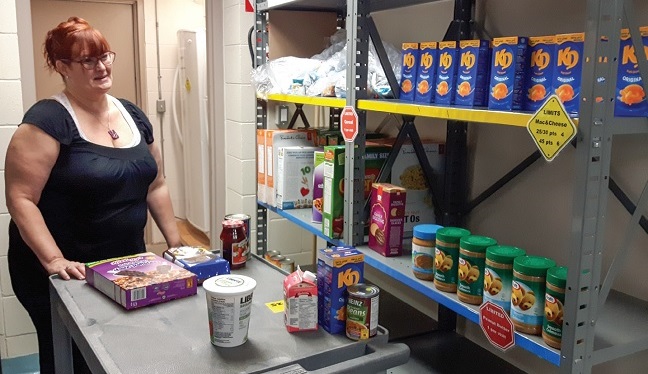The Salvation Army food bank in Midland, Ont., serves an average of 195 families each month, and we are always looking for ways to improve the experience of those who walk through our doors. Radically overhauling our system was an intimidating prospect, but our experience over the past year and a half has proved it was well worth it.
In June 2014, our staff attended an Ontario Association of Food Banks conference where we learned about the point value food distribution system. Under this system, clients are given a certain number of points based on family size. Instead of receiving a pre-packed box, the clients become “shoppers” who can spend their points on various items in the food bank.
I approached our corps officer about bringing this system to our food bank. I explained how giving our clients an opportunity to make their own food choices was empowering, and how this system fit with The Salvation Army's core value of dignity. We were soon developing a pilot project.
We spent many hours on the details of how this system could work in our food bank. We took apart our existing food boxes to determine how many points each contained. Then we added more points to account for milk, eggs and extras that we offered but weren't necessarily included in the pre-packed boxes. We put a lot of thought into determining how many points each size of family would receive at each visit.
We devised a colour-coded system, assigning a different colour for each point value. We decided to put coloured stripes on our shelves and coloured stickers on each product to easily display point values. We designed a new floor plan to accommodate shoppers. We even created a checkout area where we could monitor the points used and help our clients bag their selections.
We set out to do a two-month pilot, starting April 1, 2015. We felt that as our food bank was on a once-a-month visit guideline, our clients would need two chances to have this “shopping” experience to fully appreciate the system. We devised a questionnaire that our clients could fill out after their second visit to get their feedback.
The first day was nerve-racking. When people made their food selections, many were confused. Anticipating this, we had extra volunteers assigned as “personal shoppers” to walk people through the process. Several clients commented that they liked selecting their own items, while one felt it was too much work. We expected mixed reviews.
The second day was different. Word had already spread in our small town about the change and some clients were excited to “shop.” We still had to help people navigate the system but things were smoother and faster. By the second week we had it down pat.
Overall, things went better than we could have asked for. By May, every client we talked to at their second visit loved the point system, and some even said it was fun. Imagine that! Given the reaction of the clients, we made a unanimous decision: we were never going back to the old system.
Along with improving our clients' experience, we now have much better control over our inventory. If an item isn't moving off the shelves, we have a “special” and mark it down in point value. We offer meal packs, complete with recipes—a great way to use less-selected items. Items that used to sit for months, such as toiletries and hygiene products, fly off our shelves. Condiments and baking supplies that were not asked for or offered before are now in demand.
We have become a better resource for our clients. Allowing them to select only the items they need at each visit means they can look for sales at regular stores and use the food bank to fill in the gaps on their shopping list. By empowering them to be more active in their decisions, we have given our clients dignity.
Kim Duquette is the program services worker at Midland Community Church, Ont.
In June 2014, our staff attended an Ontario Association of Food Banks conference where we learned about the point value food distribution system. Under this system, clients are given a certain number of points based on family size. Instead of receiving a pre-packed box, the clients become “shoppers” who can spend their points on various items in the food bank.
I approached our corps officer about bringing this system to our food bank. I explained how giving our clients an opportunity to make their own food choices was empowering, and how this system fit with The Salvation Army's core value of dignity. We were soon developing a pilot project.
We spent many hours on the details of how this system could work in our food bank. We took apart our existing food boxes to determine how many points each contained. Then we added more points to account for milk, eggs and extras that we offered but weren't necessarily included in the pre-packed boxes. We put a lot of thought into determining how many points each size of family would receive at each visit.
We devised a colour-coded system, assigning a different colour for each point value. We decided to put coloured stripes on our shelves and coloured stickers on each product to easily display point values. We designed a new floor plan to accommodate shoppers. We even created a checkout area where we could monitor the points used and help our clients bag their selections.
We set out to do a two-month pilot, starting April 1, 2015. We felt that as our food bank was on a once-a-month visit guideline, our clients would need two chances to have this “shopping” experience to fully appreciate the system. We devised a questionnaire that our clients could fill out after their second visit to get their feedback.
The first day was nerve-racking. When people made their food selections, many were confused. Anticipating this, we had extra volunteers assigned as “personal shoppers” to walk people through the process. Several clients commented that they liked selecting their own items, while one felt it was too much work. We expected mixed reviews.
The second day was different. Word had already spread in our small town about the change and some clients were excited to “shop.” We still had to help people navigate the system but things were smoother and faster. By the second week we had it down pat.
Overall, things went better than we could have asked for. By May, every client we talked to at their second visit loved the point system, and some even said it was fun. Imagine that! Given the reaction of the clients, we made a unanimous decision: we were never going back to the old system.
Along with improving our clients' experience, we now have much better control over our inventory. If an item isn't moving off the shelves, we have a “special” and mark it down in point value. We offer meal packs, complete with recipes—a great way to use less-selected items. Items that used to sit for months, such as toiletries and hygiene products, fly off our shelves. Condiments and baking supplies that were not asked for or offered before are now in demand.
We have become a better resource for our clients. Allowing them to select only the items they need at each visit means they can look for sales at regular stores and use the food bank to fill in the gaps on their shopping list. By empowering them to be more active in their decisions, we have given our clients dignity.
Kim Duquette is the program services worker at Midland Community Church, Ont.










Leave a Comment